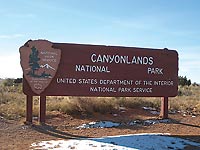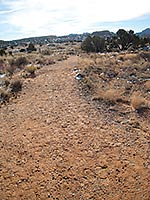In the middle of a dry land, far from the sea, a formation known as Whale Rock seems out place. Standing at its base, I’m trying hard to stretch my imagination far enough to transform this long slab of sandstone in to the image of a whale. Scratching my head I’m wondering, where did this name come from anyway?
Its history likely goes back to long before this was a national park, before paved roads conveniently brought people in for a day’s outing. Back to a time when anyone venturing this far from civilization stayed for days or even weeks.
Here’s a possible scenario. A small group of cowboys or prospectors gathers around the evening campfire. As they relax after a long, hard day, the tall tales flow. Meanwhile the sun slips below the horizon creating a halo effect. In the twilight zone when landforms take on indistinct outlines, someone jokingly says, “Wow, that rock looks like a whale.” And from then on, the name sticks.
Before the area received park status, few except Native Americans, cowboys, river runners and prospectors entered this rugged corner of southeast Utah. Even today a large chunk of these canyonlands remain an untamed territory - a huge wilderness that’s seldom touched by man - a place where bighorn sheep, coyote, deer and kit fox have enough undisturbed space to freely roam. 
In the late 1950s and early 60s, Bates Wilson, then superintendent of nearby Arches National Monument advocated for designating this unique geological area as a national park. Secretary of the Interior, Stewart Udall took the campaign to Washington in 1961. Utah Democratic Senator, Frank Moss introduced the Canyonlands Bill to congress in 1962. After many delays the bill was finally passed on September 3, 1964, and two weeks later, President Lyndon B. Johnson signed it in to law.
Island In The Sky, with an average elevation of 6,100 feet, is the highest district within Canyonlands National Park. Situated like a desert island, this sheer-walled plateau is surrounded by a far-reaching landscape that drops 2,000 feet to the banks of the Colorado and Green Rivers. On a clear day these elevated views above canyons, mesas, buttes, fins and spires offer a wondrous horizon-to-horizon panorama.
 In early December I drive up to Island In The Sky to check out the Whale Rock trail. To get there I drive ten miles north of Moab on Highway 191 and turn left on to Highway 313. From here it is 25 miles to the park’s entrance station. At the visitor center it’s six more miles to the right turn on to the Upheaval Dome Road with approximately four more miles to the Whale Rock trailhead.
In early December I drive up to Island In The Sky to check out the Whale Rock trail. To get there I drive ten miles north of Moab on Highway 191 and turn left on to Highway 313. From here it is 25 miles to the park’s entrance station. At the visitor center it’s six more miles to the right turn on to the Upheaval Dome Road with approximately four more miles to the Whale Rock trailhead.
On this chilly, foot stomping day I’m not in the mood to venture too far away, and what I find pleases me immensely - a trail that isn’t too long, nor is it too short. Instead from tail to head, the Whale Rock trail is just right. I can easily handle a one-mile round trip excursion with a gradual ascent of only 250 feet.
At an elevation of 5,650 feet, it begins with a short sandy walk through the classic desert vegetation of pinyons, junipers, yucca, and prickly pear. Almost immediately I’m moving upward as I follow the cairns (piles of rocks.) As I scamper up mounds and ledges I have a lot of fun trying to guess which direction the trail will swing to reach its final destination.
 Near where the cairns stop, I can see directly ahead the last extremely short, high stepping ascent that will take me to the top where a mind-boggling view spreads out in all directions. This presentation is so staggering in its dimensions and scope that it must be observed to be believed - a scalloped, chiseled land with monster-shaped landforms reaching up to greet a lake-blue, cloud-speckled sky - canyon after canyon marching along in all directions with the biggest gash being where the Green River flows - Cleopatra’s Chair sits above The Maze, the most remote district of Canyonlands National Park - and finally I see The Needles with its sculptured spires of prickly-pointed rocks that do portray the jagged image of needles.
Near where the cairns stop, I can see directly ahead the last extremely short, high stepping ascent that will take me to the top where a mind-boggling view spreads out in all directions. This presentation is so staggering in its dimensions and scope that it must be observed to be believed - a scalloped, chiseled land with monster-shaped landforms reaching up to greet a lake-blue, cloud-speckled sky - canyon after canyon marching along in all directions with the biggest gash being where the Green River flows - Cleopatra’s Chair sits above The Maze, the most remote district of Canyonlands National Park - and finally I see The Needles with its sculptured spires of prickly-pointed rocks that do portray the jagged image of needles.
This sensational sandstone playground with configurations galore sets the stage for a run away imagination - big towers and enlarged tapered candles - bulbous noses and overgrown protruding thumbs. I can also visualize slanted figurines with their heads tilted to the sky - flat-topped rocks capped with enormous hats – and high-walled medieval fortresses.
But wait, there’s more to add to this already stunning scene as I turn my attention to the dramatic climax on the horizon - the bunched up Bookcliffs running along the northern skyline - the distinctive silhouette of the La Sals now heavily mantled in a winter coat of pure white snow to the southeast - and in a westerly direction the elegantly snowcapped peaks of the Henry Mountains.
 Only the hardy and adaptable survive the extremes of this high desert environment. One lesson in tenacity is the pinyons and junipers that are directly beneath me. With just a pittance of dirt within a cracked wall, they amazingly cling to life as they wait for the next precious parcel of moisture to arrive.
Only the hardy and adaptable survive the extremes of this high desert environment. One lesson in tenacity is the pinyons and junipers that are directly beneath me. With just a pittance of dirt within a cracked wall, they amazingly cling to life as they wait for the next precious parcel of moisture to arrive.
Sandpaper rough, this tough old Whale Rock, which I am getting acquainted with, has been around for a long, long time – a span of eons that is hard to grasp. Weathered by water and ice, fleeced by snow, blasted by howling wind, seared by the summer sun, and jolted by rampaging, gully-washing lightning storms, he’s watched these big events for millions and millions of years as they played their part in sculpting the landscape that we see today.
Despite the breezy, nagging cold, I stay much longer than I intended. But then, I never sat on the top of a rock whale before relishing the off-season, completely-by-myself solitude. Nothing disturbs this rare silence. Even the ravens, which I do miss, haven’t flown in to rustle up a long-winded conversation.
Gradually, though, the nip in the air nudges me out of my sedentary position. I need to start moving and generate some heat! But before I leave I can’t resist another long, full circle look at this over powering landscape, which like a magnet attracts visitors from around the world.


 In early December I drive up to Island In The Sky to check out the Whale Rock trail. To get there I drive ten miles north of Moab on Highway 191 and turn left on to Highway 313. From here it is 25 miles to the park’s entrance station. At the visitor center it’s six more miles to the right turn on to the Upheaval Dome Road with approximately four more miles to the Whale Rock trailhead.
In early December I drive up to Island In The Sky to check out the Whale Rock trail. To get there I drive ten miles north of Moab on Highway 191 and turn left on to Highway 313. From here it is 25 miles to the park’s entrance station. At the visitor center it’s six more miles to the right turn on to the Upheaval Dome Road with approximately four more miles to the Whale Rock trailhead. Near where the cairns stop, I can see directly ahead the last extremely short, high stepping ascent that will take me to the top where a mind-boggling view spreads out in all directions. This presentation is so staggering in its dimensions and scope that it must be observed to be believed - a scalloped, chiseled land with monster-shaped landforms reaching up to greet a lake-blue, cloud-speckled sky - canyon after canyon marching along in all directions with the biggest gash being where the Green River flows - Cleopatra’s Chair sits above The Maze, the most remote district of Canyonlands National Park - and finally I see The Needles with its sculptured spires of prickly-pointed rocks that do portray the jagged image of needles.
Near where the cairns stop, I can see directly ahead the last extremely short, high stepping ascent that will take me to the top where a mind-boggling view spreads out in all directions. This presentation is so staggering in its dimensions and scope that it must be observed to be believed - a scalloped, chiseled land with monster-shaped landforms reaching up to greet a lake-blue, cloud-speckled sky - canyon after canyon marching along in all directions with the biggest gash being where the Green River flows - Cleopatra’s Chair sits above The Maze, the most remote district of Canyonlands National Park - and finally I see The Needles with its sculptured spires of prickly-pointed rocks that do portray the jagged image of needles.  Only the hardy and adaptable survive the extremes of this high desert environment. One lesson in tenacity is the pinyons and junipers that are directly beneath me. With just a pittance of dirt within a cracked wall, they amazingly cling to life as they wait for the next precious parcel of moisture to arrive.
Only the hardy and adaptable survive the extremes of this high desert environment. One lesson in tenacity is the pinyons and junipers that are directly beneath me. With just a pittance of dirt within a cracked wall, they amazingly cling to life as they wait for the next precious parcel of moisture to arrive.